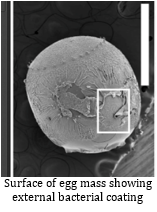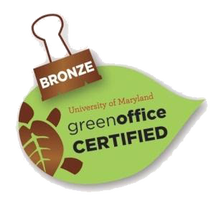 Since its accidental introduction into the Allentown, Pennsylvania area in the late 1990’s, the brown marmorated stink bug (BMSB), Halyomorpha halys, has established itself as a severe pest across much of the eastern United States. Much to farmers’ dismay, most conventional management techniques, including insecticides, do not effectively control the insect. This fact spurred the development of a working group in 2012 to research potential management strategies for the brown marmorated stink bug. The work of Chris Taylor investigating the importance of BMSB symbionts was part of this research. Taylor’s research focused on the relationship between the brown marmorated stink bug and a species of bacteria (Candidatus Pantoea carbekii) that resides in the insect’s gut, as well as on the surfaces of BMSB egg masses. He conducted a series of laboratory experiments looking at symbiont acquisition, nymphal survival, and fecundity under a variety of conditions. Are brown marmorated stinkbugs reliant on the bacteria smeared on egg mass surfaces? Previous research has shown varying levels of dependence on symbionts by different stink bug species, who obtain these symbionts be feeding on bacteria smeared on the surface of the egg mass. This resulted in the need to first confirm the level of symbiont reliance by the brown marmorated stink bug. To do this, aposymbiotic insects (those without symbionts) were generated by surface sterilizing egg masses using bleach and subsequently rearing these insects through all life stages. Survival, development time, and egg mass production was tracked and compared to stink bugs allowed to obtain their symbiont. Results indicated that BMSB is heavily reliant on its symbiont, showing significantly reduced survival, increased number of days to developmental peak, and reduced fecundity in aposymbiotic insects. Does environmental stress impact symbiont transmission or survival after transmission? Previous research has shown that some insects lose their symbionts under higher temperature conditions. In the case of BMSB, the effects of heat on the symbionts present both on the egg mass surface, and within the gut of the insect, had never previously been studied. To determine the effects of temperature on egg mass surface symbionts, egg masses were exposed to three fluctuating temperature conditions meant to mimic different mid-Atlantic summer conditions. The temperatures were classified as ‘normal’, ‘above average’ and ‘extreme’. The egg masses were exposed to one of these three temperatures, and returned to optimal rearing conditions as soon the eggs hatched. Hatch rate was calculated for each egg mass, and the ‘extreme’ condition was found to significantly reduce hatch rates and was therefore discarded. Hatch rate, survival, and percent inoculation were calculated for the ‘normal’ and ‘above average’ conditions, and no effect of temperature on the symbiont was detected. Next, Chris wanted to look at symbiont survival within the gut under heat stress. He settled for comparisons as 25 versus 30 degrees Celsius (mimicking previous studies) due to an inability to use the fluctuating conditions chambers for extended periods of time. Looking at the effects of these two temperatures on symbionts within the gut, a significant decrease in survival over time was seen in insects exposed to the higher temperature that were allowed to obtain their symbionts at birth. Additionally, decreases in fecundity were seen in the bugs at the higher temperature, as well as a drastic reduction in the number of bugs that still had their symbionts as adults. Results from these experiments indicated that the symbionts present on the surface of the egg mass are not likely affected by heat stress, but that heat stress over time has the potential to kill the symbiont within the gut of the bug. Can antimicrobial products remove the symbiont from the egg mass, and can this be used as a possible management strategy? The final experiments investigating the relationship between the brown marmorated stink bug and its’ gut symbionts addressed the potential for exploiting this relationship as a possible avenue of BMSB control. Using commercially available products with antimicrobial properties, Chris treated the symbionts on the egg mass surface like any other field crop disease, and tested to determine if any of these products had the potential to sterilize the egg mass surfaces. A total of six products were tested, and nymphs from each treatment were screened for the presence of gut symbionts. Of these six products, three were found to significantly reduce the number of BMSB able to obtain their symbiont from the egg mass surface. The findings of Chris Taylor’s research contribute much to the understanding of the complicated relationship between this insect and its symbionts. Future research is needed to determine sterilization efficacy of these products in a field setting, and to tease apart the different abiotic conditions that may limit BMSB’s host range. Further Reading: Taylor CM, Coffey PL, DeLay BD, Dively GP (2014) The Importance of Gut Symbionts in the Development of the Brown Marmorated Stink Bug, Halyomorpha halys (Stål). PLoS ONE 9(3): e90312. doi:10.1371/journal.pone.0090312  About the Author: Veronica Johnson is a Master’s student whose research focuses on determining the role of different post-harvest litter management practices in the degradation of Cry proteins in genetically modified Bt corn. She is also looking to determine the effects of winter temperature and precipitation on both tissue decomposition and protein degradation under these various litter management practices. Comments are closed.
|
Categories
All
Archives
June 2024
|
Department of Entomology
University of Maryland
4112 Plant Sciences Building
College Park, MD 20742-4454
USA
Telephone: 301.405.3911
Fax: 301.314.9290
University of Maryland
4112 Plant Sciences Building
College Park, MD 20742-4454
USA
Telephone: 301.405.3911
Fax: 301.314.9290

 RSS Feed
RSS Feed




